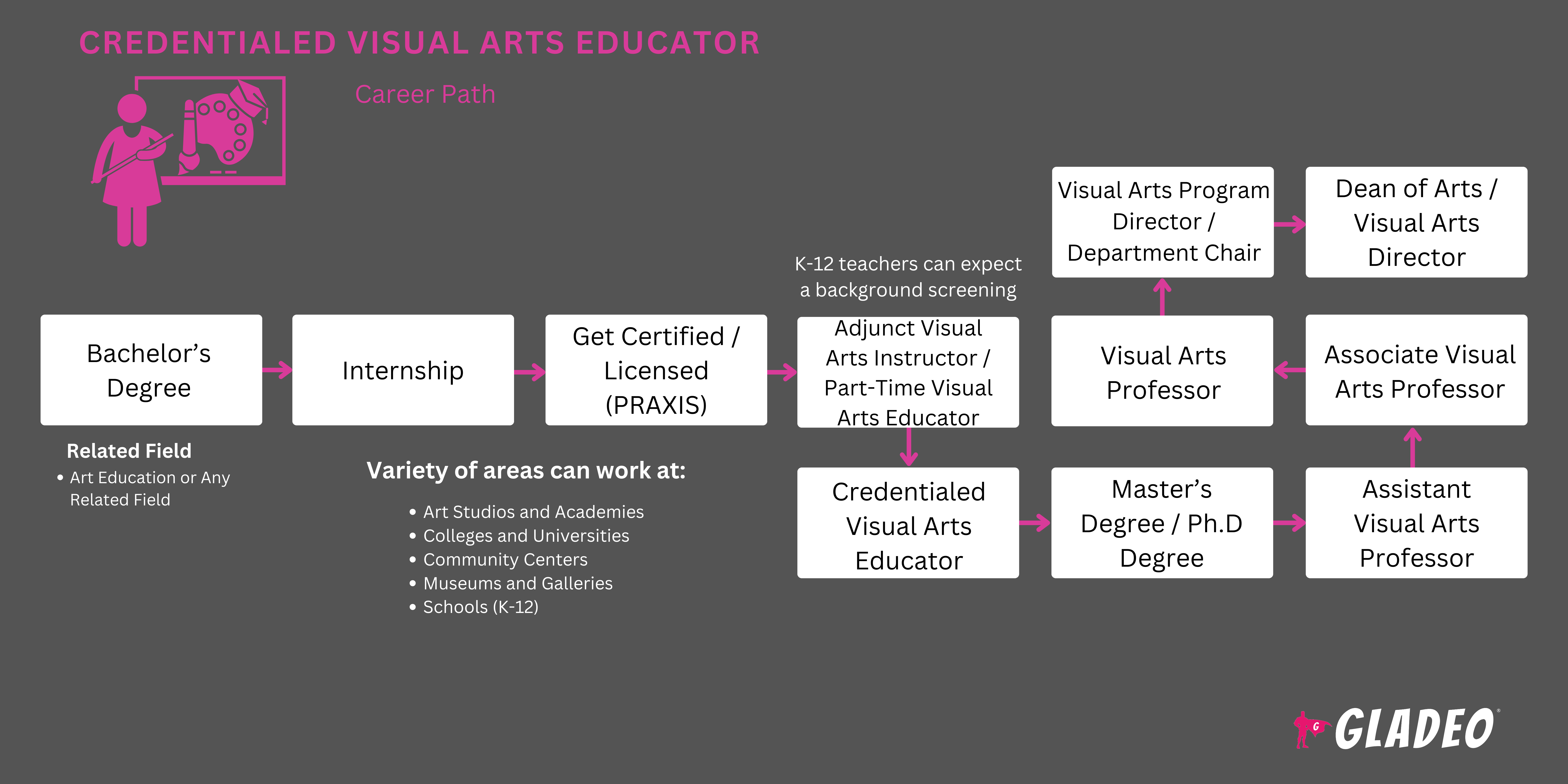Spotlights
Certified Art Teacher, Visual Arts Instructor, Licensed Art Educator, Professional Art Educator, Accredited Art Teacher, Credentialed Art Instructor, Visual Arts Facilitator, Certified Fine Arts Educator, Licensed Visual Arts Teacher, Qualified Art Educator
Students dread certain classes, but one class that’s generally loved by all is Art! Art Educators report high job satisfaction because they enjoy teaching a subject students like learning. There’s less stress and more creativity for everyone involved. Some art classes deal with the academic side of things, like art history, but the majority get classrooms involved through hands-on practice.
Unlike typical subjects taught in K-12 settings, such as math, English, or science, there are fewer formal rules or formulas when it comes to teaching art. Instead, Art Educators help learners discover concepts and techniques for creating visual works of art, showing them how to use materials and tools of the trade while encouraging them to explore ideas. Whether its medium is pencil, ink, paint, or even photography, Art Educators must be enthusiastic about the topic and able to pass on that passion. They’re also responsible for instilling a proper understanding of colors, composition, styles, and other important matters relevant to art production.
- Working in a field most teachers (and students) genuinely love
- Helping students discover latent talents
- Watching students develop into budding artists
- Enabling positive learning environments where students can unwind and express themselves, which is good for mental wellness
- Contributing to the future of the wider world of arts
Lịch làm việc
- Arts Educators work full-time jobs during regular school hours. As with any teaching job, there may be after-hours work required to prepare lessons or grade assignments. K-12 teachers can expect off-time as dictated by the academic calendar of holidays and breaks.
Nhiệm vụ tiêu biểu
- Prepare engaging daily lessons and classroom activities
- Review art history to discuss famous and significant works of arts and various styles
- Review elements that pertain to creating visual art, such as lines, 2-D shapes, textures, 3-D forms (i.e., the volume of height, width, and depth), space (perspective), color wheels, and value (i.e., lightness or darkness tones)
- Assign art projects and review instructions with students
- Dạy sử dụng hợp lý các công cụ và tài liệu áp dụng cho các dự án cụ thể
- Guide students along their creative journeys as they explore their own styles
- Thiết lập các dự án cộng tác cho phép các nhóm làm việc cùng nhau
- Assign and proctor quizzes and exams; grade assignments and offer feedback
- Demonstrate the safe use of hazardous or toxic art supplies, such as glue, paint thinner, scissors, etc.
Trách nhiệm bổ sung
- Hỗ trợ những học sinh đang gặp khó khăn hoặc khó khăn trong học tập
- Encourage and motivate students to express themselves appropriately
- Chia sẻ ý tưởng chương trình giảng dạy với lãnh đạo nhà trường và giảng viên
- Impart to students the need to take good care of their tools and materials (which can be expensive)
- Hướng dẫn các lớp học cách giữ cho khu vực làm việc sạch sẽ và có tổ chức
Kỹ năng mềm
- Mong muốn và năng khiếu giúp người khác thành công
- Đồng cảm và kiên nhẫn
- Nhiệt huyết
- Nhận thức xã hội và văn hóa được thông báo
- Kỹ năng tổ chức nhạy bén
- Phương pháp giảng dạy không phán xét
- Tháo vát
- Kỹ năng phối hợp và hướng dẫn hoạt động
- Kỹ năng giao tiếp mạnh mẽ
- Khả năng theo dõi và đánh giá hành vi của học sinh
Kỹ năng kỹ thuật
- Knowledge of art history and the elements of creating visual art
- Familiarity with all applicable tools and supplies relevant to the level being taught
- Art and craft supplies may include: various weights and types of paper, canvas, crayons, pastels, charcoal, markers, graphite drawing pencils, sharpeners, colored pencils, ink pens, paintbrushes, trays, thinners, acrylic paint, oil paint, watercolors, tempera, sponges, glue, glue sticks, paste, rubber cement, pom poms, beads, glitter, string, yarn, felt, scissors, rulers, erasers, tape, felt, gloves, and hand cleaners
- Familiarity with classroom presentation equipment (such as video magnifiers, televisions, etc.)
- Kiến thức về máy in, máy quét và thiết bị photocopy
- Microsoft Office, ứng dụng Google, phần mềm Macintosh
- Use of school database systems
- Làm quen với phần mềm giáo dục được thiết kế cho học sinh K-12
- Các trường công lập và tư thục K-12
- Trường bán công
- Post-secondary educational institutions (community colleges, universities)
- Youth centers and daycares
Art Educators play crucial roles in the well-rounded social and emotional development of students, from early childhood into high school and beyond. They help instill or grow creative skills and aptitudes that students will use throughout their lives, regardless of their eventual professions or life choices. It can be hard to quantify the tangible benefits that youth acquire from learning about and creating art. Because of that, some teachers (and parents) may not fully appreciate the value of art lessons for students of all ages. Nonetheless, Art Educators must stay positive and press on, confident in the knowledge that their work makes a major, long-lasting (and sometimes life-changing) impact in the lives of every student they teach!
Art Educators may sometimes experience frustration if their STEM (Science, Technology, Engineering, and Mathematics) peers hog more of the limelight. That said, recent years have seen the evolution of STEM into STEAM (Science, Technology, Engineering, Arts and Math) as both the worlds of academia and business realize the vital role that art and creativity play in the development of STEM innovations.
Recent times have seen an increase in the use of technology in the classroom and a rise in distance learning when appropriate for student safety. Art Educators have had to stay flexible and work with these changes, using them to promote the creation of art in exciting new ways (such as making contemporary digital art). Indeed, digital art has been transforming the art scene in recent years, making its way into museums around the globe!
As you guessed by now, most Arts Educators loved creating art growing up. Many had an early aptitude for drawing or painting; others might have discovered art in their teens as an outlet for expressing their ideas, inner thoughts, and occasional turmoils. Although there’s a stereotype about the “restless” artist, a lot of artists are not only quite happy and content but passionate about sharing their enthusiasm with others. This desire to teach is also a trait that might have been developed early on, perhaps through helping younger siblings or classmates.
- Like most teachers, Art Educators require a bachelor’s degree with a minimum GPA in a relevant major, such as Art Education
- Students must complete a teacher preparation program as part of their degree
- Hầu hết các chương trình luyện thi giảng dạy đều kết hợp thực tập để cho phép thời gian thực hành hướng dẫn sinh viên ở lớp bạn muốn dạy
- Một kỳ thực tập thường xảy ra sau hai năm đầu đại học của bạn
- Students work under the guidance of a trained teacher, who will conduct observations and provide feedback on your teaching efficacy
- After education requirements are finished, you will likely require a state license or certification. In both cases, it is necessary to pass a state-approved exam
- Lưu ý, các yêu cầu khác nhau tùy theo loại tiểu bang và trường học (công lập so với tư thục)
- Those who’ve graduated without doing a teaching prep program can earn experience through alternative certification
- The American Board for the Certification of Teacher Excellence offers resources on alternative certification
- You can also check out Teacher Certification Degree’s Alternative Teacher Certification Guide for a full exploration of this topic
- Most states require teachers to pass a Praxis exam. This may include a Core Academic Skills for Educators or only a Praxis Subject Assessment related to art
- Teachers should expect a background screening prior to licensure, which will look at criminal history and potentially credit history
- Some states or employers prefer teachers to obtain a master’s at some point
- Các yêu cầu khác bao gồm:
- Nhận thức và cam kết về sự đa dạng và bình đẳng trong trường học
- Làm quen với máy tính, máy tính bảng, phần mềm văn phòng và môi trường học tập dựa trên Internet
- Làm quen với ngôn ngữ thứ hai ở một số trường học
- Các bài kiểm tra kỹ năng bổ sung, nếu làm việc với thanh thiếu niên có nhu cầu đặc biệt
- You must ensure your school is regionally accredited and that your program is also accredited by an applicable institution
- Most states won’t grant licensure or certification if your degree is not from a regionally accredited school and a program accredited by the National Council for Accreditation of Teacher Education (NCATE) or the Council for the Accreditation of Educator Preparation (CAEP)
- Always compare costs of tuition, room and board, and scholarship opportunities (in addition to federal financial aid for students)
- Decide which is best for you, a traditional on-campus experience, online courses, or a hybrid program
- Pay close attention to any in-person requirements when signing up for an online degree. You don’t want any surprises after you’ve enrolled!
- Look for programs that publish graduation and job placement statistics. Many schools serve as pipelines for local employers they maintain strong ties with
- Suffice it to say, take plenty of art courses!
- Art Educators also need skills in written and verbal communication, leadership, project management, and teaching pedagogy
- Volunteer at your school to help with projects that build leadership and project management abilities
- Take courses to help you prepare for real-world classroom teaching, such as public speaking, psychology, special education, and behavior management
- Find paid or volunteer opportunities beyond the school, such as working for youth organizations, religious centers, or childcare centers
- Learn about current diversity and social standards in K-12 settings
- Learn to express yourself concisely and clearly. Be comfortable with yourself so that students will feel comfortable in the creative learning environment you build for them!

- Loại bỏ tất cả các yêu cầu giáo dục và chuẩn bị của bạn, bao gồm bất kỳ giấy phép hoặc chứng chỉ nào do tiểu bang yêu cầu, kỳ thi Praxis, v.v.
- Liệt kê tất cả các công việc, giáo dục và hoạt động ngoại khóa của bạn trong sơ yếu lý lịch của bạn, cần được đánh bóng và chỉnh sửa cao
- Sử dụng kết quả có thể định lượng được khi có thể, chẳng hạn như thống kê về kết quả thành công và số lượng sinh viên bạn đã làm việc cùng
- Giữ liên lạc với những người giám sát và giáo viên cũ của bạn, bao gồm cả người cố vấn thực tập của bạn. Những cá nhân này có thể đóng vai trò là tài liệu tham khảo vô giá khi đến thời điểm
- Set up job notification alerts on Indeed.com, EdJoin.org, and other job portals and keep track of application deadlines
- Đọc kỹ các bài đăng tuyển dụng và đảm bảo đưa các từ khóa có liên quan vào sơ yếu lý lịch của bạn
- Thể hiện nhận thức và trình độ liên quan đến eLearning và các xu hướng khác
- Know your terminology when it’s time to interview. Keep up-to-date on new Art Education developments
- Let your enthusiasm for teaching art shine! Don’t be afraid to authentically show your passion for the job. Employers want to see evidence of your soft skills as well as academic qualifications
- Earn your master’s degree, or complete additional training/advanced certifications
- Demonstrate sincere caring for children’s educational progress in the arts
- Explore opportunities beyond the walls of your current place of employment and even out-of-state, if necessary to grow
- Build your reputation as a classroom leader with strong management skills
- Mentor others when you can, and offer to help with college students doing their internships
- Participate in professional organization activities (see our list of Recommended Websites below)
- Serve on high-visibility school and district committees; build rapport with staff, peers, parents, and administrators
- Be an advocate for student rights
- Keep students motivated by incorporating new ideas, techniques, and technologies
- Read books, review website resources, watch videos to get new ideas, and keep your classrooms fresh, fun, and forward-thinking!
Trang web
- Liên đoàn Giáo viên Hoa Kỳ
- Art Pedagogy
- Art Rabbit
- Arty Factory
- Colossal
- Felt Tip Pen
- Văn hóa và nghệ thuật của Google
- Hiệp hội Giáo dục Nghệ thuật Quốc gia
- Hiệp hội Giáo dục Quốc gia
- Hiệp hội phụ huynh giáo viên quốc gia
- Tate trẻ em
- The Art Teacher
- The Arty Teacher (YouTube channel)
Sách vở
- The Art Teacher's Survival Guide for Secondary Schools: Grades 7-12, by Helen D. Hume
- The Art Teacher's Book of Lists, by Helen D. Hume
- Fifty K-12 Art Lessons: Black & White Edition: Creative Differentiated Explorations In Art, by Eric Gibbons
- Classroom Management for Art, Music, and PE Teachers, by Michael Linsin
If becoming an Art Educator isn’t your thing, but you’re still interested in launching a successful career in the education sector, the Bureau of Labor Statistics lists plenty of “Plan B” opportunities to consider! Here are just a few:
- Giáo viên ESL
- Giáo viên hướng nghiệp
- Hiệu trưởng nhà trường
- Giáo viên mầm non và tiểu học
- Middle School Teachers/Postsecondary Teachers
- Cố vấn trường học và nghề nghiệp
- Giáo viên giáo dục đặc biệt
- Trợ lý giáo viên
Nguồn cấp tin tức

Việc làm nổi bật

Các khóa học và công cụ trực tuyến







